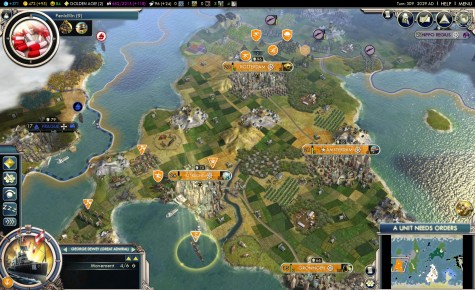Game Review: Sid Meier’s Civilization V

Sid Meier’s Cvilization V is a turn-based, strategy game for a capable computer. It based off the original civilization board game. It is an improved version of the previous Sid Meier’s Cilivalization Game, Sid Meier’s Civilization IV.
When starting off the game, a player has preset civilizations to pick from; 18 if it’s the base game, and 43 civilizations if one owns all downloadable content. The players have options to pick whatever civilizations they desire or take their chances with a random leader. A few of the civilizations are Rome with Augustus Caesar, Greece with Alexander the Great, Washington with The United States, the Danish, Germany, Mayans, Etuphoia, and many more. All civilizations have special stats, units, perks, and abilities.
The game view is an overhead of the revealed or discovered land mass to the player of their civilization. It shows their cities, units, natural resources and terrain nearby. The land is randomly generated, though it’s possible to edit the game before a game launch, if you have an option to do so. Editing a game involves resource abundance, terrain and land mass generated, how many other civilizations and city states are spawned in, difficulty, if there is an option, and what era all civilizations start in. Eras refer to to how advanced a player’s civilization is and may include ancient era, renaissance, modern eras, like the informational era, and beyond. The advancements include technology such as animal husbandry, metal casting, currency, combined arms and computers.
Once a player starts a game off, they must found a city with a starting settler. The best places for founding a city are near natural resources, hopefully being close to a player’s starting point. Though being picky about a starting location for a city can mean a player doesn’t advance at the start as quickly. A player should try to keep up or surpass other civilizations to try and earn a victory.
As a city is settled, the player must use their natural resources, production of buildings, to move their cities production, growth and development faster along while advancing technology. They have units available to their growing empires. Service units are used for improving tiles of land or trade and military units for defending or conquering. As players continue along, its almost certain that they should expand their territories by their own means while, also acquiring new resources for strategic or luxury reasons. While all this being done, the player must balance their budget for the economy and maintain their population’s happiness for a successful civilization. Not being well budgeted or losing happiness has negative impacts on a player’s ability to grow, produce buildings and units, and keep a population from rebelling.
The game can be won through different means. Either by who has the best score with the amount of limited time or turns. A domination victory can be achieved by conquering all other civilizations through a brilliant tactic or brute force. A science victory comes from being the first to launch a spaceship with the purpose of colonizing another habitable planet. A diplomacy victory is a victory in which a world’s congress all agrees on having a certain player become the world leading civilization. Finally, a culture victory, is achieved by using culture produced by a player’s civilization to fill out five possible social policies then, begin a Utopian project to win.
The game is multiplayer online or offline to compete against the computer program. Offline can be played locally with the same computer with other people. People who enjoy strategic long sitting games should try the game themselves or research the game then decide for themselves.
Chris Henry is Senior Writer and Reporter for The Cougar Call at Ada High School. He's new to Journalism and having to to adapt to the ways of reporting...






